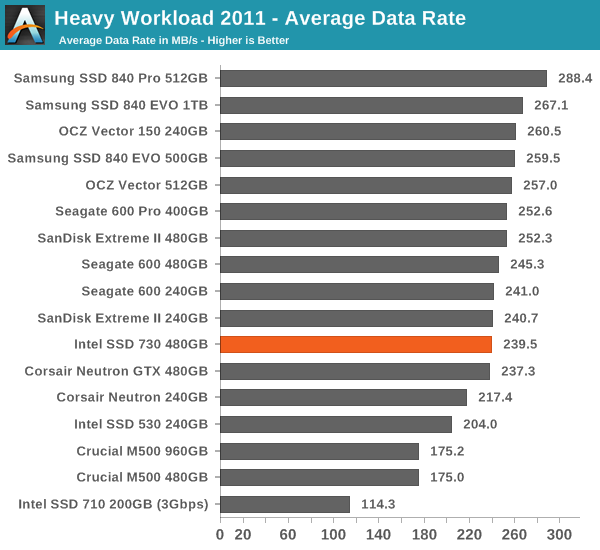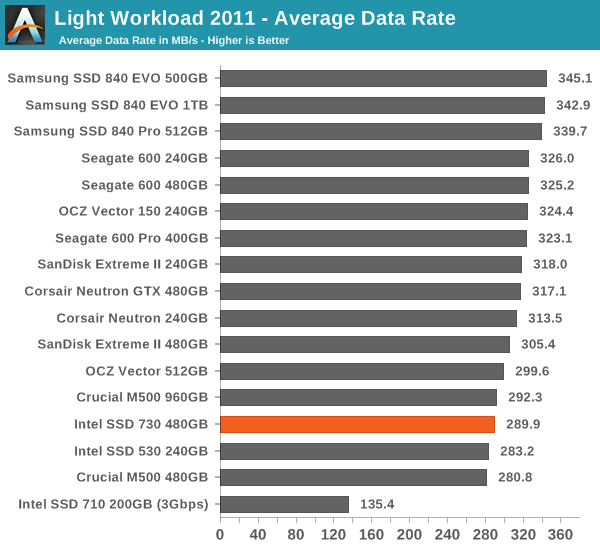Intel SSD 730 (480GB) Review: Bringing Enterprise to the Consumers
by Kristian Vättö on February 27, 2014 12:00 PM EST- Posted in
- Storage
- SSDs
- Intel
- Intel SSD 730
AnandTech Storage Bench 2011
Back in 2011 (which seems like so long ago now!), we introduced our AnandTech Storage Bench, a suite of benchmarks that took traces of real OS/application usage and played them back in a repeatable manner. The MOASB, officially called AnandTech Storage Bench 2011 - Heavy Workload, mainly focuses on peak IO performance and basic garbage collection routines. There is a lot of downloading and application installing that happens during the course of this test. Our thinking was that it's during application installs, file copies, downloading and multitasking with all of this that you can really notice performance differences between drives.
We tried to cover as many bases as possible with the software incorporated into this test. There's a lot of photo editing in Photoshop, HTML editing in Dreamweaver, web browsing, game playing/level loading (Starcraft II & WoW are both a part of the test) as well as general use stuff (application installing, virus scanning). We've included a large amount of email downloading, document creation and editing as well. To top it all off we even use Visual Studio 2008 to build Chromium during the test.
The test has 2,168,893 read operations and 1,783,447 write operations. The IO breakdown is as follows:
| AnandTech Storage Bench 2011 - Heavy Workload IO Breakdown | ||||
| IO Size | % of Total | |||
| 4KB | 28% | |||
| 16KB | 10% | |||
| 32KB | 10% | |||
| 64KB | 4% | |||
Only 42% of all operations are sequential, the rest range from pseudo to fully random (with most falling in the pseudo-random category). Average queue depth is 4.625 IOs, with 59% of operations taking place in an IO queue of 1. The full description of the test can be found here.
AnandTech Storage Bench 2011 - Heavy Workload

AnandTech Storage Bench 2011 - Light Workload
Our light workload actually has more write operations than read operations. The split is as follows: 372,630 reads and 459,709 writes. The relatively close read/write ratio does better mimic a typical light workload (although even lighter workloads would be far more read centric). There's lots of web browsing, photo editing (but with a greater focus on photo consumption), video playback as well as some application installs and gaming.
The I/O breakdown is similar to the heavy workload at small IOs, however you'll notice that there are far fewer large IO transfers.
| AnandTech Storage Bench 2011 - Light Workload IO Breakdown | ||||
| IO Size | % of Total | |||
| 4KB | 27% | |||
| 16KB | 8% | |||
| 32KB | 6% | |||
| 64KB | 5% | |||

Again, the SSD 730 comes up with relatively uninspiring performance in this lighter, older workload. If your usage patterns are relatively tame, a drive designed for enterprise usage scenarios may be more than you need and may actually end up performing slower than "lesser" drives in day-to-day use—not that you'd likely notice, as most decent SSDs are now at the point where to normal users they're all plenty fast.










96 Comments
View All Comments
futrtrubl - Friday, February 28, 2014 - link
"JEDEC's SSD spec, however, requires that client SSDs must have a data retention time of one year minimum whereas enterprise drives must be rated at only three months"I hadn't actually thought about this before for SSDs and after doing some checking around this seems to be the minimum retention time once the endurance cycles have been exhausted.
Presumable this retention time is higher for sectors that are not exhausted. Does anyone know what sort of retention times could be expected from fresh/moderately used drives?
The next question would be do controllers move once written data around to refresh this data and/or as part of wear leveling (like OS files that are untouched after the install)?
Mr Perfect - Friday, February 28, 2014 - link
I don't know about your first question, but the answer is "yes" to your second question about the wear leveling. Controllers try to keep writes even across all blocks to keep endurance up.futrtrubl - Saturday, March 1, 2014 - link
Sorry, that was a badly worded question but yes I am aware that wear leveling exists. What I am asking is, if you write a file once and then only read from it for the next few years while the rest of the drive is being written/rewritten, will the controller intentionally rewrite or move that file? Whether it does it for wear leveling or to refresh "old" data is less important but would be nice to know, if it does.Solid State Brain - Tuesday, March 4, 2014 - link
SSD-spec NAND memory is supposed to have a 10 years data retention when fresh (0 write cycles). I haven't been able to find much real world data about it, but from a Samsung datasheet about their enterprise drives, inclusing those with TLC NAND memory (here http://www.samsung.com/global/business/semiconduct... ) one can extrapolate that for the rated endurance with sequential workloads at 3 months of data retention, TLC NAND cells would have to endure about 2000 write cycles.So very roughly, assuming it's the exact same memory of the consumer drives (no reasons to assume it's not the case) for these drives we have: 0 write cycles = 10 years retention, 1000 cycles = 1 year retention, 2000 cycles = 3 months retention. Torture tests by users worldwide have shown that at over 3000 write cycles, these drives have a data retention ranging from hours to days. So, we could further summarize this as:
cycles / data retention days
0000 3650
1000 365
2000 36.5
3000 3.65
If you plot these values you can see that there's an inverse exponential correlation between NAND wear and data retention.
Solid State Brain - Tuesday, March 4, 2014 - link
It turns out I realized too late before clicking "reply" that for the 2000 cycles datapoint I used about one month of time instead of 3 months. It should be 90. It doesn't affect the end point I was making, though.SiennaPhelpsigi - Saturday, March 1, 2014 - link
Parker . I can see what your saying... Margaret `s bl0g is impressive, last thursday I bought a great Porsche 911 from having made $8447 this past month an would you believe 10 grand this past month . this is certainly the most-comfortable job I've ever had . I began this nine months/ago and pretty much immediately began to bring home over $77, per-hour . Learn More W o r k s 7 7kmmatney - Saturday, March 1, 2014 - link
You can make that kind of money, in real life, as an engineer. Why is their a shortage of engineers in the U.S.again?Jflachs - Saturday, March 1, 2014 - link
So um, the 840 Pro is still the best SSD then, right?emn13 - Sunday, March 2, 2014 - link
None of samsungs drives have any form of power loss protection, so unless you really need that last bit of performance, I'd avoid them, especially since there are cheaper drives that do have that protection.If you really do need top-of-the line performance, well, then your choice becomes considerably harder.
amddude10 - Friday, November 28, 2014 - link
Power-loss protection isn't very important in a laptop or if someone has a good UPS on a desktop, or at least that's what I would think, so in those cases, samsungs look very good indeed.